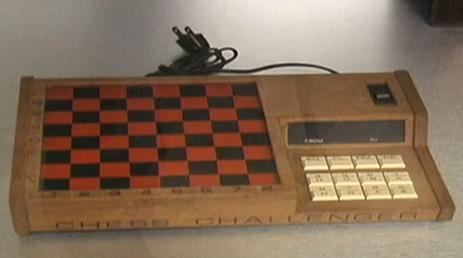Deep Blue and its predecessors

Twenty years ago, a historic chess game took place on 11 May 1997: World Chess Champion Garri Kasparov played against a computer called Deep Blue. And for the first time ever, the machine won.
Feng-hsiung Hsu and his team started work on the predecessor of the chess computer in 1985 at Carnegie Mellon University, and continued development work after transfer to IBM in 1989. This is when the project, called Deep Thought until then, was renamed Deep Blue in reference to IBM’s traditional blue colour. The supercomputer, based on IBM’s RS/6000 SP system with 30 microprocessors, was capable of evaluating an average of 200 million positions in practice, and its database contained 4000 opening moves and 700 thousand grandmaster games, as written about the machine in an article published by Index on the anniversary of the day.

The match that ended with the machine winning can be looked upon as the triumph of the human mind: the construction of a chess-playing machine was a plan that humanity had cherished for centuries. The Exhibition on Computer History, managed by the John von Neumann Computer Society (NJSZT), includes a series of information panels that introduces prominent figures in Hungarian computer science. Wolfgang von Kempelen (Hungarian: Kempelen Farkas, 1734-1804) is presented at the exhibition as the forefather of Hungarian cybernetics thanks to the fascinating machines he constructed as early as the 18th century.
Kempelen’s chess-playing automaton, The Turk was a hoax rather than a real automaton since a human chess player concealed inside the machine moved the pieces. Nevertheless, Kempelen was a genius, which he demonstrated with his speaking machine or his typewriter for the blind (which pressed embossed characters) just to mention two of his inventions that did work, while The Turk became a solid part of pop culture. For instance, the French mystery film Thinking Robots (Le collectionneur des cerveaux), made in 1976, was inspired by the story of the chess-playing automaton even though the inventor in the film, a late successor of Kempelen, resorts to more gruesome tricks than illusionists.
In 1912 Leonardo Torres y Quevedo built a workable electromechanical chess automaton, which was able to play a king and rook endgame against king played against a human chess player. One of the most distinguished personalities in Hungarian cybernetics, the engineer Tihamér Nemes (1895-1960), who is also a member of the „golden team” of prominent figures in Hungarian computer science at our exhibition, also worked on designing chess machines, as it is revealed in the book Cybernetic Machines, published on the basis of notes put to paper by Nemes.

Chess-playing served as an important example in the research John von Neumann did in the field of game theory. The fundamentals for computer chess programmes were specified by Alan Turing while the first steps towards chess-playing computers were taken by Claude Shannon, the founder of information theory. Early digital computers were already used for writing simple chess programmes. For instance, the MANIAC, which was based on the von Neumann architecture of the IAS, was also used for writing chess programmes in Los Alamos Laboratory in 1956. (The name MANIAC was jokingly short for "Metropolis and Neumann Invent Awful Contraption", at least according to the recollections of László Jéki.)
Chess-playing programmes on large mainframe computers also inspired Stanley Kubrick. In 2001: A Space Odyssey, HAL the supercomputer, the artificial intelligence in control of the entire spaceship, also plays chess with the astronauts. The speaking computer (which unfortunately becomes deranged and attempts to kill the crew) is perhaps the most beautiful – and most formidable – representation of artificial intelligence in film art.

In the mid-1970s and then on, commercially sold chess-playing computers entered people’s homes (the first one, the prototype of Fidelity was released in 1976, and the manufacturer later released a version combined with a speech synthesizer). Chess computers built in chess boards or sold separately in a kit were special purpose computers, and quite a cult developed around them in the 1980s. Commodore released its chess computer (ChessMate) in the late 1970s, and Mephisto, a line of chess computers, became the most popular chess computer in Europe in the 1980s. In Hungary, NJSZT published the first magazine on computer science Mikroszámítógép Magazin, which was aimed to reach students as well. László Lindner, a legendary chess master, had a chess computer section in NJSZT’s magazine. Hungary also organised one of the World Microcomputer Chess Championships.

One can find absolutely extraordinary solutions among chess computers: for instance, the firm NOVAG introduced a robotic chess machine which had a robotic arm to make moves on the board.
Dedicated chess computers were also created in Hungary in the late 1980s, however, the prototype of the firm Color Ipari Szövetkezet never went into production in the end.

Alongside chess computers, more and more advanced chess programmes were created for personal computers as well. The 1 kilobyte chess programme for the ZX-81, manufactured in 1981, was of course a piece of cake for professional chess players. In 2016, the John von Neumann Computer Society dedicated Researchers’ Night to playing chess at the Exhibition on Computer History. International Woman Grand Master, Petra Papp played simultaneous games with visitors and played against ZX-81 (and not surprisingly, Petra won).
A long time will pass before machines are able to learn all the rules of chess playing perfectly, what’s more, are capable of „thinking" ahead and making strategies in possession of the information about the possible combinations of moves.
Figuratively speaking, humanity was „checkmated” in 1997 by artificial intelligence, which is about to change our everyday life fundamentally twenty years later. And to give a more recent example, AlphaGo, artificial intelligence that plays the board game Go, which is far more complex than chess, triumphed over human players in 2016.
Gábor Képes
Sources:
https://chessprogramming.wikispaces.com/
Jéki László: http://fizikaiszemle.hu/archivum/fsz0312/jeki0312.html
http://index.hu/tech/2017/05/11/deep_blue_20_eve_kaszparov_sakk_mesterseges_intelligencia/

